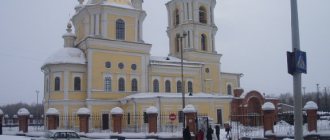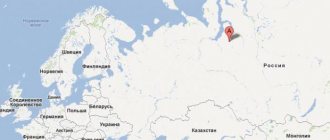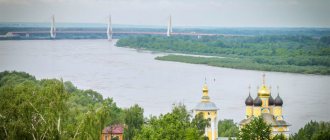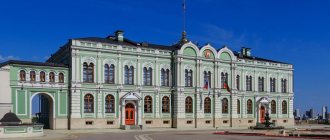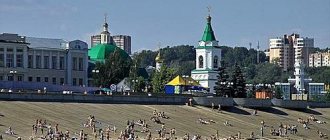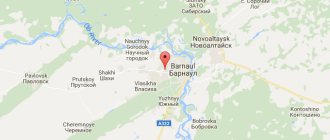The Volga city, which until 1964 was called Stavropol, and is now called Togliatti, is located in the Samara region, the only settlement and territorial unit of the urban district with the same name. Convenient location on the left bank of the Volga River, wide transport interchange, the presence of a port and large railway junctions make it favorable for living.
Middle Volga region
As part of the Volga Federal District, its southern part, called the Middle Volga region, is distinguished. On both sides of the longest river in Europe lie the Penza, Ulyanovsk, Saratov and Samara regions, as well as the Republic of Tatarstan. This is where Tolyatti is located. Which region shelters a modern industrial city on the left bank of the Volga? Despite the 18th place in the country in terms of population (more than 712 thousand people) and occupied area (more than 315 square kilometers), Togliatti is not a regional administrative center.
The Middle Volga region is a densely populated and economically developed territory with an advantageous geographical location and developed infrastructure. Convenient transport links have a beneficial effect on the development of the engineering, oil refining, gas and chemical industries for which the region is famous. 74% of the population live in cities. The territory is located in a temperate continental climate zone, where hot summers (+25 ° C) and little snowy winters with sub-zero temperatures (average values are 12-15 degrees below zero) are clearly distinguishable. But there are frosts down to -30 °C. The border with the Lower Volga region passes through the Zhigulevskaya hydroelectric station, where Togliatti is located.
Which region contains the Volga city?
The Samara region, bordering Tatarstan, Orenburg, Ulyanovsk and Saratov regions, is located in the southeast of the East European Plain. It consists of 11 cities and 23 villages, united into 27 districts. Tolyatti is the administrative center of the Stavropol region in the north-west of the region, 59 km away from the regional capital. The distance between the cities along the highway is 88 km and can be covered in about 2 hours. Residents of the region have no question about how to get to Tolyatti, where a magnificent recreation area is located. Shuttle buses run every half hour from all train stations in the city.
Located at the junction of three zones - forest-steppe, steppe and forest - the Samara region has only 12.6% forest cover. Broad-leaved trees are found in the north of the region, including in the Stavropol region, where residents of the regional capital flock during the holiday period.
Culture
Theaters
The culture of Tolyatti is a unique phenomenon for a young Russian city. There are 4 professional theaters here: Drama Theater "Wheel", Puppet Theater "Pilgrim", Youth Drama Theatre, Theater for Young Spectators "Stagecoach". The “Theater for Children and Youth” festival is held annually, in which school groups take part along with professional and studio theaters.
Museums
The holdings of municipal museums - the Togliatti Museum of Local Lore and Art, the City Museum Complex "Heritage" - exceed more than 829,000 items. These are documents and objects of ethnography, painting, sculpture. The house of the Starikov family, located today on Sovetskaya Street, has also been preserved, which was the first to be moved from Stavropol, which was under flooding. The museum and park complex “Technical Museum named after G.K. Sakharov” has become a unique phenomenon not only in Tolyatti, but throughout Russia. The museum is located in the open air on a land plot of 38 hectares. Its territory houses more than 460 different exhibits demonstrating the development of automobile, armored, aviation, railway equipment, as well as missile, artillery and naval weapons. Among them are samples of various weapons from the times of World Wars I and II, and space technology. The B-307 submarine, which was delivered to the museum from its service location in its entirety, deserves special attention. The boats of this project are the world's largest diesel submarines.
Music and art education
Professional musical and general aesthetic training in the city is provided by the Togliatti Conservatory (Institute), a music school, 16 institutions of additional education for children, including the choreographic school named after M.M. Plisetskaya. Outstanding Russian teachers consider it their professional duty to support new Togliatti undertakings, and young Togliatti talents have the opportunity to receive an education at the Moscow and London Conservatories. Maestro Vladimir Spivakov, who, by the way, is an Honorary Citizen of Tolyatti, took over the patronage of several talented musicians.
Concerts
Vivid cultural events were festivals held by the Tolyatti Philharmonic: Tolyatti Musical Autumn, Jazz Spring in Togliatti, International Festival of Bayan Music “Vivat, Bayan! Sergei Voitenko and friends”, as well as the International festivals “Classics over the Volga” and “Classics Open fest”.
Monuments
Tolyatti is included in the federal list of historical cities of Russia, where about 120 architectural and sculptural cultural monuments are located. Over half of them are located in the Central region. The Eternal Flame burns on Freedom Square, and the Obelisk of Glory rises in honor of those killed during the Great Patriotic War. In Portposelok, on the banks of the Volga River, a monument to the founder of the city, V.N. Tatishchev, was erected. It was built with voluntary donations from citizens, Tolyatti philanthropists and enterprises. The author of the monument is world-famous sculptures Alexander Rukavishnikov.
Samarskaya Luka
The Samara region is located in the middle reaches of the Volga River, where the largest bend (meander), called the Samara Luka, was formed with a coastline of 230 km. It stretches for 60 km from west to east and 30 km from north to south, from the village of Usolye to the city of Syzran. In fact, Samara Luka is washed by the waters of two reservoirs - Saratov and Kuibyshev - and the small Usa River. The answer to the question about Togliatti: “Which region has it in its composition?” - is known to most Russians precisely because the city is located on the banks of the Kuibyshev Reservoir. Kuibyshev was the name of the city of Samara until 1991.
The most picturesque section of the Samara Luka is the distance from Samara to the locks of the Zhigulevskaya hydroelectric power station, the crown of which is the Zhiguli Mountains (height - 375 meters). The river in this place is not wide, and tourists can clearly see how the hill drops steeply towards the Volga. Hydroelectric power stations and mountains are located on the right bank of the river, where the city of Zhigulevsk is located. On the left, at the junction of the low-lying and forest-steppe Trans-Volga region and Samarskaya Luka, Tolyatti stretches (a photo of the city and Samarskaya Luka is presented in the article).
Geographical position
It is located 70 km upstream of the Volga River relative to the capital of the Samara region. The length of the borders is 149 km. The city is not part of the Stavropol region and, in addition to it, borders on Zhigulevsk. The issue of connecting these two cities has been discussed for a long time, but so far this is just a project. From the south the city connects with the dam of the Kuibyshev Reservoir, from the east it is surrounded by forests, and from the north-west by agricultural land.
Tolyatti on the map of Russia can be found at the following coordinates:
- 53° 31′ north latitude;
- 49° 25′ east longitude.
The city is located in the Samara time zone. Its offset relative to Moscow time is +1 hour. The region is in daylight saving time, which also results in a shift relative to UTC.
Popular message topics
- Works of Leonid Andreev
Leonid Nikolaevich Andreev was born in Orel in 1871. From early childhood he showed an interest in books. He received his first training at the Oryol gymnasium. A literature teacher instilled in him an interest in creativity - Hare
The class of mammals is quite large, it even includes such an interesting animal as the hare. Everyone knows that this animal is quite friendly and does not rush at people. But it turns out that sometimes hares become aggressive and even attack - Phenicia
Unfortunately, modern historians cannot provide us with accurate information about all ancient states, cities and territories. Over time, the boundaries of the location of the territories of the states themselves and the territories of their influence changed.
A little history
06/20/1737, after the return of the Orenburg expedition led by Tatishchev, Anna Ioannovna granted a charter for the founding of the city to Princess Anna Taishina for the construction of a fortress in order to gather all baptized Kalmyks in this place. This date is considered the founding day of the settlement. There is an opinion that the city of Tolyatti was born three times throughout history. What region existed at that time on the site of Samara? In the 50s (moving from a flooded low-lying area), the city was part of the Kuibyshev region, which launched the construction of a hydroelectric power station named after. Lenin (the old name of Zhigulevskaya). The created base for grandiose construction was later used to found chemical enterprises (KuibyshevAzot, TogliattiKauchuk, TogliattiAzot) and the Volzhsky Automobile Plant. The decision to build AvtoVAZ marked the third birth of the city, because it caused a huge influx of young people and contributed to significant population growth.
In 1964, by decision of the federal authorities, the city of Stavropol was renamed Togliatti in honor of Palmiro Togliatti, head of the Italian Communist Party. He died the day before while in the USSR. The Italian politician had nothing to do with the city that bears his name for 82 years, so the issue of returning the original name is widely discussed by the public.
Crime
- Hello! We are from Tolyatti. - Why are you threatening right away?!
Togliatti became the unofficial criminal capital back in the dashing 90s and has not yet lost this dubious glory. It was in Togliatti that 20 years ago there were fierce wars between organized criminal groups, the victims of which, unfortunately, were not only members of various organized crime groups, but also ordinary civilians. And today, city guests sometimes specially come to the city cemetery to look at the so-called “alley of heroes”, where crime bosses and members of their gangs are buried.
Why was Togliatti attractive to criminal elements of all stripes, and what was the reason for the real massacre that took place in the city in the early 1990s? The answer is simple - it is AvtoVAZ.
It all started back in the 80s with the banal theft of auto parts, which were in great short supply in those days. Of course, we are not talking about carrying parts in trouser pockets or throwing boxes of spare parts over the factory fence. C, loaded with stolen parts. 10 years later, organized crime groups, which had already divided the city into spheres of influence, launched a real war to establish control over AvtoVAZ. No one could even think that the city would have to endure three waves of violence associated with the struggle for criminal supremacy in Tolyatti.
The bandits were well aware that huge amounts of money were circulating at VAZ, but for the time being the only thing they succeeded in doing was robbing car buyers outside the plant. This was not enough. It all started with the occupation of factory checkpoints and the Zhiguli store, the only official factory store in Tolyatti.
In 1992, bandits began to control the shipment of cars from the plant. This business turned out to be the most profitable. Using a scheme developed by Vladimir Bilichenko, organized criminal groups drove away about 30 thousand cars annually. This is too tasty a morsel for everything to go quietly and peacefully. The first conflicts began to arise between the factions.
The first Great Racketeer War began. It was initiated by the “Agievskaya” organized crime group led by Vladimir Agiy and Alexander Voronetsky, who decided to take AvtoVAZ under their sole control. To implement their plans, they turned to Oleg Khoroshev’s gang, nicknamed “Podarok”, which agreed to shoot competitors for a substantial reward.
The first target of the “Agiyev” group was the former thimblemaker Vladimir Vdovin, nicknamed “Partner,” who headed the “Partner” organized crime group. By mid-1992, Vdovin had practically taken over the Zhiguli store. Despite all efforts, none of the attempts was successful. After this, the “Agievskys” switched their attention to the leaders of the “Kupeyevskaya” group, Sergei and Garry Kupeev. However, the Kupeev brothers were also too tough for them. The next target of the Agievskys was Vladimir Bilichenko, who failed to survive the assassination attempt. From that moment on, bloody showdowns between organized criminal groups began.
The first war lasted more than a year. As a result, the criminal world lost such authoritative bandits as Vladimir Bilichenko, Sergey Kupeev, Alexander Maslov, Alexander Voronetsky, Vladimir Dorovskikh “Sivy”. Some of the bandits went missing. Instead of Maslov, Dmitry Ruzlyaev, nicknamed “Dima Bolshoi,” became the head of the “Volgov” organized crime group. The maximum benefit from this war was received by Vdovin, who, remaining the only representative of the “old guard,” rose to the very top of the Tolyatti criminal hierarchical ladder. Without his participation, not a single serious issue was resolved in the city.
Vladimir Vdovin
As a result of the subsequent two wars between organized crime groups, almost all authoritative bandits were either killed or imprisoned for long periods. Over 10 years of conflict, more than 500 people associated with the criminal world died. The only person who managed to go through all the showdown and stay alive is Vladimir Vdovin, nicknamed “Partner”. Today he has retired and lives in one of the European countries.
Territory, administrative structure
Today Togliatti, a photo of which you can see on the page, occupies an area of about 315 square meters. km, 25.5% of it is urban forests. This is the greenest city in the Samara region. There are significant distances between its three administrative districts, stretched along the Volga for 40 km. 36% of the city territory is occupied by the Avtozavodskoy district, where the AvtoVAZ premises are located. It is separated from Central by 3 km of forests. The Komsomolsky district is another 5–7 km away. In terms of area, it, like Central, occupies 32% of the entire city territory.
Since its founding, the city has had its own coat of arms in the form of a fortress with a cross in the middle. The head of the executive branch is the mayor; today this post is occupied by S.I. Andreev. Legislative power is concentrated in the hands of the Tolyatti City Duma, consisting of 35 deputies. In October 2015, Tolyatti (Samara region) received the status of a single-industry town, since the social well-being of the majority of residents depends on the situation at the main enterprise of the region - AvtoVAZ.
Ecology and climate of Tolyatti
In general, the climate of Tolyatti can be defined as clearly continental. This means that in summer it is hot here (on average +21), and in winter it is quite cold (again, on average -11). The proximity of the Kuibyshev reservoir and the forests separating the city's districts have a beneficial (mitigating) effect on the climate.
Tolyatti in winter
For a long time, Tolyatti residents (especially people of the older generation) determined the weather “according to Moscow” (and, I must say, very successfully). For example, if a sharp cold snap is declared in Moscow today, then in 2 days it’s time to get warmer clothes for the residents of the automobile capital. However, in the last 2-3 years this pattern has been breaking down more and more often. And the weather both in Tolyatti and throughout the Samara region is in most cases determined by the southern regions of our vast homeland.
The ecological situation of the city leaves much to be desired. And if previously the main culprits here were the largest industrial enterprises, shrouding the city in a bluish haze of atmospheric emissions (residents of the Central region suffer especially), today the main source of air pollution is transport (cars account for about 70% of harmful substances emitted into the atmosphere). According to statistics, every third Togliatti resident is a car owner.
Along with vital oxygen, dust, carbon monoxide, sulfur dioxide, nitrogen oxides and volatile organic compounds pass through the lungs of Togliatti residents (to a greater or lesser extent, depending on where they live) every day.
Such a disastrous situation is saved by the introduction of modern wastewater treatment plants into production (thanks to them, industrial pollution in the city has halved over the past 10 years), as well as vast areas of green space within the city and forests outside it.
Avtozavodskoy district
Residents distinguish between themselves the territory of the New and Old Towns. The first includes the Avtozavodskoy district, the population of which significantly exceeds the total number in the other two and amounts to more than 436 thousand inhabitants. It occupies the western part of the city, overlooking the banks of the Volga. Its structure is divided into 28 blocks, inside of which there are parks and boulevards. Major roads separate the neighborhoods from each other. But such development is not typical for all of Togliatti, the map of which gives an idea of the characteristics of each administrative district. In addition to AvtoVAZ, it is on the territory of the New City that light industrial enterprises known in the region are located: a champagne wine factory, a dairy factory and a clothing factory.
This is the youngest area, the housing stock of which began to be built simultaneously with the construction of the automobile plant. And the only one where the birth rate exceeds the death rate. New houses are being built right in the forest area, expanding the boundaries of the city.
Enterprises and work in Tolyatti
Just a few years ago, Tolyatti was one of the most prosperous Russian cities from an economic point of view. The well-known Forbes magazine, compiling a ranking of the most attractive Russian cities for business, in 2008 gave Togliatti a very honorable 5th place, and called the city itself the largest economic and industrial center, which plays an important role not only in the economy of the region, but also the country as a whole.
Unfortunately, today the situation has changed significantly. And not at all for the better. The global financial crisis has taken a toll on the Tolyatti economy. Therefore, the once prosperous city with ambitious plans is now again forced to conquer lost positions.
The city-forming enterprise of Tolyatti is the Open Joint-Stock Company "AVTOVAZ" - a plant specializing in the production of LADA passenger cars. Today, more than 66,000 people work here, including about 5,000 temporary workers. A full package of social guarantees, stability, a clearly fixed working day and the opportunity to “work hard” from time to time - all this makes the plant still the most attractive workplace for Togliatti residents.
AvtoVAZ
Also on the territory of Togliatti there are several other large enterprises in the engineering industry. This is "GM-AVTOVAZ" - an automobile plant, which is the fruit of the joint work of Togliatti residents and their American colleagues, the group, which is a large industrial holding company specializing in the production of a wide range of various products (from automotive to defense), "Detalstroykonstruktsiya", "Johnson" Control Togliatti" - a plant for sewing covers for cars, "VazInterService" - a company supplying components to car assembly plants in Russia and abroad, and "AvtoVAZagregat".
The list of large industrial facilities in the city continues with two combined heat and power plants - the Volzhsky Automobile Plant CHP Plant and the Togliatti CHP Plant - and an impressive group of chemical industry enterprises. The latter is represented by TogliattiAzot, the world’s largest ammonia production plant, KuibyshevAzot, specializing in the production of mineral fertilizers, and Togliattikauchuk, a plant producing synthetic rubber.
It is also worth noting the dynamically developing food industry (the city has its own meat processing plants, dairy and bakeries, a distillery, a champagne and cognac plant, a winery), enterprises specializing in the production of electrical equipment, factories producing plastic and rubber products and other types of industrial production.
The banking sector is well developed, there are many insurance companies that take an active part in the economic life of Tolyatti. Small businesses are doing well.
It would seem that a city with so many large industrial facilities is simply doomed to prosperity. However, for the past few years, Tolyatti residents have been living in constant fear - “What does the coming day have in store for us?” After mass layoffs during the crisis years, the myth about the stability of work “at the bench” was finally dispelled. And wages still cannot recover from the shock and reach at least the pre-crisis level.
There are lively “discussions” taking place in the local press and at large city forums (of course, if this definition can be applied to the dialogue between statements of the federal authorities and ordinary Togliatti residents). The reason for the indignation of Avtograd residents is the greatly inflated official statistics, according to which the average monthly salary in the city is about 20,000 - 21,000 rubles. This is understandable. After all, an ordinary factory worker (and these are the majority at AvtoVAZ) receives an average of 11-13 thousand rubles per month, an employee of Togliattikauchuk - about 12 thousand, teachers - 8-10 thousand rubles, managers of car dealerships and travel agencies - 12,000-15,000 rubles, and salespeople, cashiers, operators and other employees of federal retail chains (of which there are a great many in the city) – no more than 15,000. It doesn’t even smell like 20 thousand...
And here we must say thank you to the small, but so important for the extras, leadership team, hiding, like secret agents, in the cozy offices of the VAZ high-rise building. It is thanks to these soldiers of the invisible front with official salaries of several million rubles that the standard of living of Togliatti residents “on average” looks very decent!
AvtoVAZ office
Komsomolsky district
About 120 thousand people live in the easternmost region, located directly on the banks of the Volga downstream. It is adjacent to the Zhigulevskaya hydroelectric power station dam and goes directly onto the M5 federal highway. It is here that the river port of the city is located, where tourists traveling along the Volga stop. The most beautiful embankment is the real pride of the area, whose production enterprises are located at a considerable distance from residential buildings: TogliattiAzot, AvtoVAZagregat, VAZINTERSERVICE.
Previously, the village of Kuneevka was located on the territory of the district, so the private sector and buildings from the 50s have been preserved for a long time. Despite the excellent location of the area, real estate here is not in great demand. Residents prefer to travel from 20 to 60 minutes, but live in more comfortable houses. This part of Tolyatti (the city map gives an idea of the area) belongs to the historical values of the metropolis. The 19th century churches are located here: St. Tikhon’s and Annunciation monasteries. The Shlyuzovaya microdistrict (former village) is called mini-Petersburg due to its buildings in the classicist style.
central District
The name itself suggests that the location of the district is the central part of the city, where about 160 thousand residents live. It is this one that bears the unofficial name of the Old Town, which primarily indicates the state of the housing stock. Houses were built here during the reign of Khrushchev and Stalin. A map of Tolyatti with streets clearly demonstrates that the building principle differs from the “square-nested” one in the Avtozavodsky district. In the center there is a park, which has city status, and a central square, from which streets run in radii to different ends of the district, although the system of names for the blocks is preserved.
Residents of the Old Town in everyday life are considered more intelligent and are compared with residents of the city on the Neva, who differ from Muscovites. The private sector is significantly represented here, where class stratification is obvious. Along with small dilapidated houses, elite cottages are being built, guarded by a pack of dogs. On the Volga bank lies the Portovy microdistrict, considered a real paradise town in Togliatti (Samara region).
Migration
In 2021, there is an outflow of residents living in Togliatti: out of 18,643 residents who arrived, 18,795 left. The net migration loss of population was 153 people, while in 2021 this figure was positive and amounted to 3020 inhabitants. The majority are young people aged 25-30.
A constant migration exchange of city residents is observed with the CIS countries - 4,213 people left and 3,871 arrived. The difference was 342 people, while in the previous period the number of arrivals exceeded the outflow of residents by 3,868 people.
The most active directions of natural increase in migration:
- Kazakhstan.
- Armenia.
- Tajikistan.
- Uzbekistan.
People travel from Togliatti more often to the following countries:
- Armenia.
- Kyrgyzstan.
- Tajikistan.
The countries with the least demand for both entry and exit are Moldova, Turkmenistan and Belarus.
Population
The city is rightfully considered young, because its population is young. According to the latest census, the average age of Togliatti residents is slightly higher than 39 years (39.2). To detain young people, more than 20 higher educational institutions have been opened in the city, although in Soviet times there was only the Togliatti Polytechnic Institute and a military school (now the Military Technical Institute). The main population is people of working age, only 150 thousand people are pensioners. The nineties went down in the history of the city with sad events: the growth of drug addiction and HIV infection among young people. Today the situation has stabilized somewhat.
More than half of the residents are women. Togliatti, the city map of which does not give an idea of the national composition of the population, is 83.2% populated by Russians. Other nationalities include Tatars, Ukrainians, Mordovians, Chuvashs.
Social politics
Education
The education system in the city is one of the most developed. There are 69 pre-school educational institutions, 80 general education institutions, 18 institutions of additional education for children. The basis of higher education is made up of state universities, including Tolyatti State University and Volga State University of Service. There are two non-state universities - the Tolyatti Academy of Management and the Volga University named after. Tatishcheva. There are also many branches of Moscow, St. Petersburg and Samara universities in Tolyatti. In 2009, JSC AVTOVAZ opened its own educational institution - a corporate university. 1,684 Togliatti teachers were awarded industry awards from the Ministry of Education and Science of the Russian Federation.
Healthcare
The healthcare industry is represented by municipal and state healthcare institutions, as well as private medical offices of various profiles. Equipping hospitals and clinics, operating rooms and treatment rooms, hospital wards with the most modern equipment, organizing departments of gentle endoscopic surgery, careful study and prompt implementation of new methods of treating patients - this is the general trend in the development of all medical associations in Togliatti.
Attractions. How to get there?
The city attracts tourists due to its proximity to the Zhiguli Mountains. Every year, on the first Sunday in July, art song lovers gather in the vicinity of Tolyatti for the Grushinsky Festival (new name - “Platform”). Hundreds of thousands of participants come to the Mastryukov Lakes, where songs by talented performers from all over Russia are heard in memory of the deceased Valery Grushin. Therefore, many people have a question: “Where is Togliatti, which region of Russia organizes the festival of bard song?”
The most convenient way to get to the city is by air. Kurumoch International Airport is 50 km away, with regular buses and taxis. It is important to decide which part of the city a person needs to get to: New or Old, because these are completely different routes. In summer, it is easy to get to the city by water, taking a fascinating walk along the Volga. You can also get there by rail, but the main railway junction is not in Tolyatti. The map will help you decide on a train to Samara, the capital of the region, from where there are regular buses, intercity minibuses and taxis.
